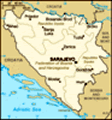Advertisement
Published: April 12th 2020
Rain poured down this morning, putting the final kibosh on the boat trip around a nearby island park that was originally on the itinerary but is now closed. I was happy because I didn’t want to go on the boat trip anyway. Yesterday’s anti-motion pill made me foggy enough to lose my glasses, and a repetition on a boat was too much to contemplate.
Much better was the substituted visit to Čilipi and the Konavale ethnographic museum where fabric arts displayed ordinary life in history. The knowledgeable and enthusiastic guide spoke at some length about the embroidered and woven items in a woman’s dress. Each item, such as belt, apron, vest, and head-covering, conveyed certain information about her, for example, if she were single, engaged or married. Even within one day, she might change some of the garments to indicate that she was doing housework, visiting, or going to church. The decorative patterns were associated with these “status updates”. The museum had about thirty drawers with artifacts collected from older women.
The existence of the museum itself was due to the smart actions of the staff. When the fighting from the
1991 war came close, they hid all their artifacts
in a disused dry cistern in the kitchen, thus saving them from the destruction of the building by bombs.
On the way to
Ston, we stopped to look at two magnificent, huge
plane trees that seemed to have escaped most of the ravages of war. A park surrounded the bigger tree, and a substantial cement pillar supported one of the thick branches. (Not very different from
Ta Prohm temple in Cambodia.) Here we made a group photo.
The rain had changed our lunch plans, which had included a ten-minute walk in Dubrovnik. Even a one-minute walk would have soaked us. Thus, we had accelerated our schedule to visit Ston. Before lunch, the lightening of the rain allowed us to take some photos of the astonishing 15 century wall that climbed high into the surrounding hills - the second longest wall in the world, after the Great Wall of China. After lunch the rain poured again, and the planned walk on the wall had to be cancelled.
Lunch was wonderful! Menka had chosen the restaurant from the internet while we were busy admiring the embroidery at the museum. The menu of
Backus Restaurant was almost exclusively sea food. Mussel farms were

 Ston Walls 15 century
Ston Walls 15 century
Steep climb, too much in the rainin the water all along the calmer inlets, and I was delighted to order them for lunch. All the dishes were gigantic; at one kilo, my mussels in a garlic butter sauce was one of the smaller offerings (because so much of the weight is shells). This
Pelješac Peninsula is known for its excellent red wines, and I did my own research, enjoying the tannic, fruity flavour.
In the pouring rain we took a short walk to a local grocery store, which resulted in the buying and eating of chocolate. Very satisfying.
Back in the bus, I noticed how much lusher was the vegetation in this region and saw the trees covered in the white flowers again. Vineyards were quite visible because they hadn’t grown much yet this year and looked like wide slashes in the landscape.
The main road from Dubrovnik to
Mostar (and Split) crosses borders three times. Bosnia has a narrow neck to give it access to the sea, but the road continues along the coast and before turning inland. Croatian passport control and customs let us out, Bosnia let us in; twenty minutes later, Bosnia let us out, Croatia let us in. Half an

 Villa Fortuna, Mostar
Villa Fortuna, Mostar
Modern hotel in the old cityhour later, Croatia let us out and Bosnia let us in.
Bosnia is mostly inhabited by Muslim Serbs, although there are many Christians, too. Minarets immediately came into view as we entered the main part of the country. Quite few spired churches were evident, too. Towns lined the highway. The houses were fairly similar to the ones in Croatia, perhaps with less pitch to the roofs. In one town, garbage was strewn, not seen anywhere else we have been. Actually, it looked like the aftermath of a flood, and the roads were somewhat flooded from the rain.
At the hotel
Villa Fortuna, no other guests were present. Don’t know why. This made changing rooms easy when the manager discovered a leak in the bathroom where Elizabeth and I were to stay. We lucked out, because the new room had three beds, giving us space to put things.
After about an hour’s rest (or writing notes in my case), we met in the lobby to walk to Tomato Restaurant right beside the old Mostar bridge, now rebuilt since the war. Fortunately, the rain had subsided to a trickle and had produced a rainbow, beautifully lit by the evening sun

 Old Bridge, Mostar
Old Bridge, Mostar
Built 1567, rebuilt 2004 after the warover the hills across the river. Dinner was a jolly event, featuring Bosnian food: roughly chopped tomato, cabbage and lettuce salad; stuffed peppers, vine leaves and cabbage rolls in a light tomato sauce; fresh fruit and Bosnian cake soaked in honey; plus, local red wine (quite light).
View map of trip to date.
Advertisement
Tot: 0.138s; Tpl: 0.02s; cc: 13; qc: 30; dbt: 0.0611s; 1; m:domysql w:travelblog (10.17.0.13); sld: 3;
; mem: 1.2mb




























Isabel Gibson
non-member comment
Lovely
Lovely sights and images from the Croatian weaving like the roofs of Dubrovnik (wow!) to the engineering of the Old Bridge in Mostar (whose V-shape speaks to a day before some advance in arch building that I likely should know the name of but don't), . Interesting, too, to read of a menu that sounds reasonably similar to Greek, Turkish and Lebanese foods I have known.